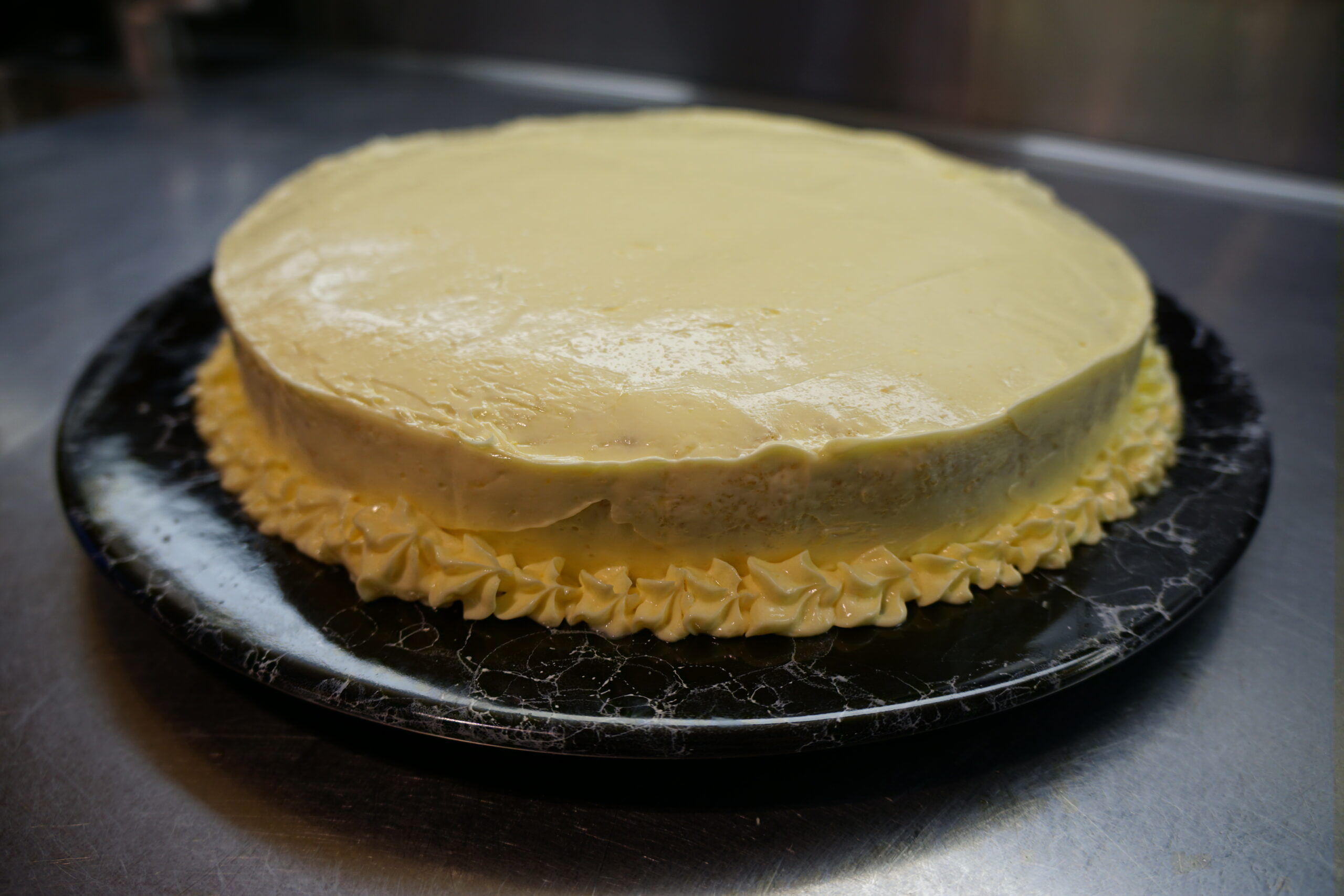1¼ pounds unsalted butter
2 teaspoons vanilla
8 large eggs plus 6 egg yolks
Scant 2½ cups sugar
1 cup sifted cake flour
1 cup minus 2 tablespoons cornstarch
½ cup liqueur (we use lemon-flavored rum)
½ cup corn syrup
Preheat the oven to 350° F. Butter and flour two 9-inch pans. (Note that what is pictured is a half-recipe, cooked in a single 9-inch pan.)
Clarify
- ½ cup (4 ounces) unsalted butter
in a heavy saucepan. Melt the butter over medium heat, partially covered to prevent splattering. When the butter looks clear, cook uncovered, watching carefully until the solids drop and begin to brown. Pour immediately through a fine strainer or a strainer lined with cheesecloth. The result is called beurre noisette.(Some people keep this around the house, apparently – probably mostly people named Martha.) If you do, warm the 6 tablespoons beurre noisette until almost hot (110 to 120°). If you don’t wait for your newly-made beurre noisette to cool to this temperature.
Add
- 2 teaspoons vanilla
and keep warm. In a large mixing bowl set over a pan of simmering water heat
- 8 large eggs
- 1 cup sugar
just until lukewarm, stirring constantly to prevent curdling. Remove from heat. Using the whisk beater, beat the mixture on high speed for 5 minutes or until triple in volume. (A hand beater will take 10 minutes of beating.)
While the eggs are beating, sift together
- 1 cup sifted cake flour (or 1 cup less 2 tablespoons of sifted all-purpose flour)
- 1 cup minus 2 tablespoons cornstarch
Remove 1 scant cup of the egg mixture and thoroughly whisk it into the beurre noisette. Sift half the flour mixture over the remaining egg mixture and fold it in gently but rapidly with a large balloon whisk, slotted skimmer or rubber spatula until almost all the flour has disappeared. Repeat with the remaining flour mixture until the flour has disappeared completely. Fold in the butter mixture until just incorporated.
Pour immediately into the prepared pans and bake 25 to 35 minutes or until the cake is golden brown and starts to shrink slightly from the sides of the pan. (You don’t need to use a cake tester, just watch the sides of the pan.) Opening the oven door could cause the cake to fall. If you can’t see in through the glass, just open the door a crack and peek in. If it doesn’t look done, close door at once and check again in 5 minutes.
Loosen the sides of the cake with a small metal spatula and unmold at once onto a lightly greased rack. Reinvert to cool.
While the cake is baking, make the syrup. In a small saucepan with a tight-fitting lid, combine
- ½ cup plus 1 tablespoon sugar
- 1 cup water
bring to a rolling boil, stirring constantly. Cover immediately, remove from the heat and allow to cool completely. Transfer to a liquid measuring cup and stir in
- ¼ cup liqueur (we use lemon-flavored rum)
If the syrup has slightly evaporated, add enough water to equal 1½ cups.
Trim the bottom and top crust when ready to complete the cake; if left on they would become pasty. You just want to trim the thinnest possible layer off; use a large serrated knife. Trimming the cake also helps level it off. Invest in some “Magi-Cake Baking Strips” if you are serious about producing level cakes.
Sprinkle both sides of each cake with the syrup. A syringe, which we don’t own, is apparently ideal. A baster does a pretty decent job, but try not to dump too much syrup in one spot.
Make the buttercream frosting. Have a greased, 1-cup heatproof glass measure near the range. In a bowl, beat
- 6 large egg yolks
with an electric mixer until light in color. A handheld mixer will be much simpler to work with for the process outlined below. Meanwhile, combine
- ¾ cup sugar
- ½ cup corn syrup
in a small saucepan (preferably a non-stick pan), and heat, stirring constantly, until the sugar dissolves and the syrup comes to a rolling boil. The entire surface will be covered with large bubbles. Immediately transfer the syrup to the glass measure to stop the cooking.
If using an electric hand-held mixer, beat the syrup into the yolks in a steady stream. Don’t allow the syrup to fall on the beaters or they will spin it onto the sides of the bowl. If using a stand mixer, pour a small amount of syrup over the yolks with the mixer turned off. Immediately beat at high speed for five seconds. Stop the mixer and add a larger amount of syrup. Beat at high speed for five seconds. Continue with the remaining syrup. For the last addition, use a rubber scraper to remove the syrup clinging to the glass measure. Continue beating until completely cool.
Gradually beat in
- 2 cups (1 pound) unsalted butter, softened
- 2 to 4 tablespoons liqueur (again we use lemon-flavored rum)
This can be stored in an airtight bowl. Bring to room temperature and rebeat if you are not using it immediately.
Assemble the cake using the buttercream as both a filling and frosting. We both don’t like a lot of frosting, so we’d go light on the frosting, in which case you will have some left over. The recipe makes enough to generously fill and frost a two-layer 9-inch cake.
Adapted from The Cake Bible, by Rose Levy Beranbaum

